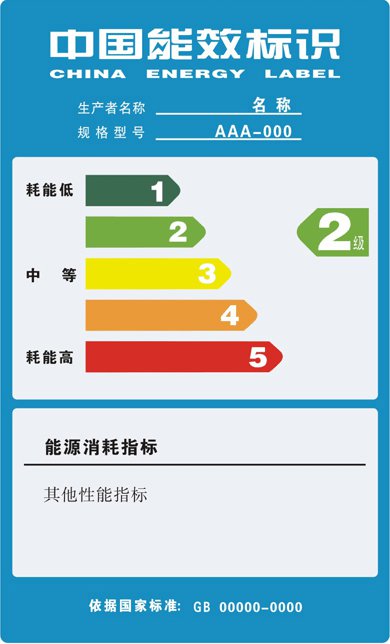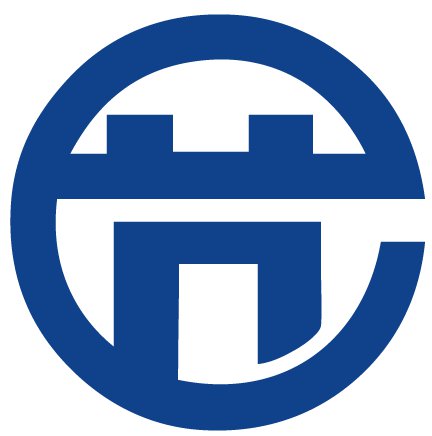
China energy label is a mandatory energy labelling scheme. Each product which is included by this labelling scheme has to be stuck a label on the product or the product package. It covers more than 35 energy using products and is the largest energy efficiency information program for consumers in China.
It is applied not only to household appliances, commercial and office equipment but also to industrial equipment such electric motors and air compressors.
The label is a categorical label with three or five energy efficiency tiers. Tier 1 illustrates the highest energy efficiency level, tier 3 or 5 illustrate the lowest energy efficiency level.
The overall aim of this policy is awareness raising and education in energy saving by disclosing product energy performance to consumers. The label guides to purchase energy efficient products, which will save energy during the using phase. By establishing the central registration database, policy makers can track the latest market and technology development of products.
It also plays the role of market access of energy using products. The products that cannot manage to meet the MEPS are not qualified to get the energy label, which means they are not allowed to be sold on the market.
China energy label did not include all the products at one time. Starting from 2005, it included the products from batch by batch according to energy consumption, penetration rate and other factors. It now covers more than 35 product categories. The product category is under expansion year by year.
The label is based on national energy efficiency standards, which set testing methods, energy efficiency requirements and energy efficiency classification. Manufacturers have to send the product sample to accredited testing laboratories. If the testing results meet MEPS, energy efficiency tier will be given at the same time. For this purpose, a central registration database, which stores the energy efficiency information for more than 600,000 product models was established. This database provides solid data basis for energy efficiency standards revising, incentive programs and other related policies.
The next figure illustrates the design of the energy label. In 2016, the label was replaced by a labelling scheme that includes a QR code. The reason for this replacement is the fast development of online shopping platforms and the barcode technology.

China energy label is managed by China Energy Label Center (http://www.energylabel.gov.cn/). It is a management office affiliated to China Energy Conservation Center and China National Institute of Standardization.
The label is part of a comprehensive policy package. For instance, the label is the basis of a subsidy program for energy conservation products.
In China, there is another labelling scheme, the energy conservation product certification program. It uses the same energy efficiency standards to develop the certification criteria, but this program does not disclose detailed energy information for consumers.
Outside of China, there are several other energy labelling programs with the aim to inform consumers and to influence the purchase decision. The Chinese label resembles the EU’s label. One of the differences is the ranking scale. The EU uses a A+++ to G scheme, China uses a 1 to 5 scheme.
The energy efficiency of China energy using products was quite low before the energy label was introduced. MEPS only play the role of stopping market access of very inefficient products. Manufacturers did not have the obligation to disclose the energy performance of their products, which made the collection of energy information impossible. The consumers lacked the knowledge and information channels to compare the energy performances of different products.
The overall aim of the policy is to improve the energy efficiency of energy using products and to reduce the energy consumption and CO2 emission. It aims to make the energy information transparent and to raise the awareness of consumers and promote the market transformation towards higher energy efficient appliances.
It also provides strong support for the energy efficiency revision of MEPS by tracing the market development trends.
It is a national policy.
Active options
Appliances
In addition to the minimum energy performance standards, which eliminate the most energy-consuming products from the market, the energy label has an important role in pulling the market towards more energy-efficient products.
The rules for the energy efficiency scale are formulated according to the Energy Efficiency Label Management Method. The label includes the manufacturer’s title, the product model, the energy efficiency grade, the electricity consumption in kWh/24h, the serial number and other specific requirements (e.g. volume for refrigerators).
The energy efficiency grade is identified according to the energy efficiency grade judging method (e.g. for microwave ovens: GB 24849) and a test report. For other product groups (like TVs) the Energy Efficiency Index is used to rate the energy efficiency.
China has a comprehensive policy package to increase the energy efficiency of energy using products. While minimum energy performance standards phase out the most inefficient appliances, the energy label increases the demand for energy efficient ones. There is not only a mandatory label but also a voluntary endorsement label, which provides information on the best performing products to the consumers. The label is only provided to products if they have an energy performance of at least a grade 2 level of the mandatory label.
The energy label goes hand in hand with the top runner program. If the product is selected by this program, there will be a top runner sign on the label (3 product groups are covered by the top runner program: refrigerators, air conditioner and TVs, status June 2016).
Capacity building measures and award competition are innovation driver for the best available technologies. In addition, there are several subsidy programmes for different types of products.
Furthermore, the government established a law obliging state agencies and organisations to purchase only energy-efficient appliances. This law raises awareness of energy efficient appliances by setting good example to the people.

The following pre-conditions are necessary to implement the China Energy Label
Agencies or other actors responsible for implementation
China Energy Label Management Center affiliated to China National Institute of Standardization
Funding
Funding comes from the government.
Test procedures
Test standards are published for each product group. For example, for TVs the testing way of the energy efficiency index (EEI) and passive standby power shall be pursuant to the valid edition of GB 24850. Templates to fill in the testing results are available.
All level government agencies randomly sample the products from retail market. The samples will be sent to authoritative third party testing labs. The samples will be tested and compared with the data shown on label. If the testing results cannot meet the label declared performance, the manufacturers will be informed about the negative testing results. If the manufacturers accept the third party testing lab results, they will receive punishment according to management regulation. It the manufacturers do not accept the testing results, a second testing will be conducted under the witness of the manufacturers. The second testing result is the basis of the final compliance testing judgement.
Other pre-conditions
Another precondition are MEPS for the respective product group.
The label is based on national energy efficiency standards, which set testing methods, energy efficiency requirements and energy efficiency classification. Manufacturers have to send the product sample to accredited testing laboratories. If the testing results meet MEPS, energy efficiency tier will be given at the same time. The testing report is uploaded to the central database and reviewed by energy label management. If the paper review is passed, the manufacturers are authorised to design the product model specified energy label basing on the template, print the label and stick the label on the products. The information disclosed on the label is the basis for random third-party double check in market surveillance.
International co-operations
China Energy Label took reference from European energy label program to classify the energy performance of energy using products and disclose energy efficiency information to consumers.
Actors responsible for design
China National Institute of Standardization is a public funded research institute and responsible for the design of the policy.
Actors responsible for implementation
China Energy Label Management Center affiliated to China National Institute of Standardization is responsible for implementation
Monitoring
A monitoring procedure exists. All the manufacturers have to submit the testing report of products to be labelled to a centralized management system to get the approval. The testing reports and some energy efficiency information are stored in a centralized systems and disclose part of energy information to public.
Evaluation
China has limited capacity to conduct comprehensive evaluations. CLASP conducted two consumer awareness studies of energy label in 2010 and 2013. In 2010, 61.5% of 5687 consumers saw and knew China energy label, while in 2013, 97.3% of 5920 consumers saw and knew energy label. The increasing rate of awareness shows that China energy label is now widely acknowledged by consumers. In 2013 survey, 74.5% consumers knew that tier 1 is the most efficient class.
However, the awareness level varies among different product groups. Awareness of the refrigerator label is 96% while the awareness level on laptop computers is 10% (Yu et al. 2015).
Design for sustainability aspects
In addition to the energy efficiency grade, some other aspects are covered by the energy label, like the water consumption (L/cycle) for washing machines. However, this additional information is only available for a limited number of products.
The following barriers have been experienced during the implementation of the policy
China has limited capacity to conduct a comprehensive evaluation of the energy labelling program.
CLASP conducted two consumers awareness research of energy label in 2010 and 2013. In 2010, 61.5% of 5687 consumers saw and knew China energy label, while in 2013, 97.3% of 5920 consumers saw and knew energy label. The increasing rate of awareness shows that China energy label is now widely acknowledged by consumers. In 2013 survey, 74.5% consumers knew that tier 1 is the most efficient class.

makes energy efficiency in buildings and appliances transparent. For investors, policy-makers and actors involved in implementation and consultancy. Learn more ...

© 2024 | Built by the Wuppertal Institute for Climate, Environment and Energy | All rights reserved. | Imprint | Privacy Policy
